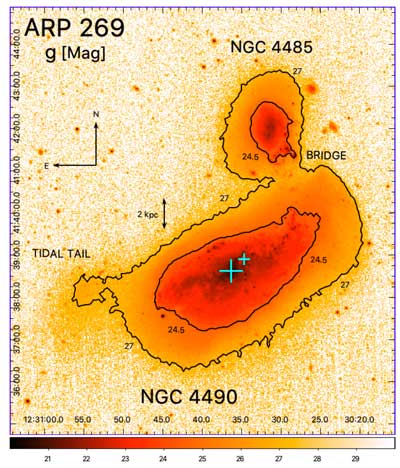| Feb 06, 2020 |
Astronomers reveal rare double nucleus in nearby 'Cocoon Galaxy'
|
|
(Nanowerk News) The so-called “Cocoon Galaxy” not only has a unique shape, it has a rare double-nucleus structure, astronomers report in a new paper.
|
|
After studying data from optical and radio telescopes based on the ground and in space, a team of astronomers determined that a galaxy known as NGC 4490 (and nicknamed the “Cocoon Galaxy” because of its shape) has “a clear double nucleus structure,” according to their paper.
|
|
One nucleus can be seen in optical wavelengths. The other is hidden in dust and can only be seen in infrared and radio wavelengths.
|
|
The paper reporting the discovery is now online and has been accepted for publication in the Astrophysical Journal ("Revealing the Double Nucleus of NGC 4490"). First author is Allen Lawrence, who earned a master’s degree in astronomy from Iowa State University in 2018 and continues to work with Iowa State astronomers.
|
 |
| SDSS g mosaic image of Arp 269. The optical extent of the two galaxies is shown using contours
at magnitude 24.5 and 27 (SDSS Pogson (Pogson 1856) magnitude system).
|
|
Lawrence started the study in 2013 while taking astronomy classes at the University of Wisconsin-Madison. He had the chance to study one of two galaxy systems and picked NGC 4490, which is interacting with a smaller galaxy, NGC 4485. The system is about 20% the size of the Milky Way, located in the Northern Hemisphere and about 30 million light years from Earth.
|
|
“I saw the double nucleus about seven years ago,” Lawrence said. “It had never been observed – or nobody had ever done anything with it before.”
|
|
Some astronomers may have seen one nucleus with their optical telescopes. And others may have seen the other with their radio telescopes. But he said the two groups never compared notes to observe and describe the double nucleus.
|
|
The new paper says both nuclei are similar in size, mass and luminosity. It says both are similar in mass and luminosity to the nuclei observed in other interacting galaxy pairs. And, it says the double nucleus structure could also explain why the galaxy system is surrounded by an enormous plume of hydrogen.
|
|
“The most straightforward interpretation of the observations is that NGC 4490 is itself a late-stage merger remnant” of a much-earlier collision of two galaxies, the authors wrote. A merger could drive and extend the high level of star formation necessary to create such a large hydrogen plume.
|
|
The astronomers said there are other reasons they find the study of this system interesting:
|
|
Struck, who studies colliding galaxies, said double-nucleus galaxies are very rare, especially in smaller galaxies such as this one. And, he said astronomers think a double nucleus could contribute to the buildup of super massive black holes found in the center of some galaxies.
|
|
And Kerton, who researches star formation, said, “This project demonstrates that using multiple wavelengths from space- and ground-based observations together can really help us understand a particular object.”
|

